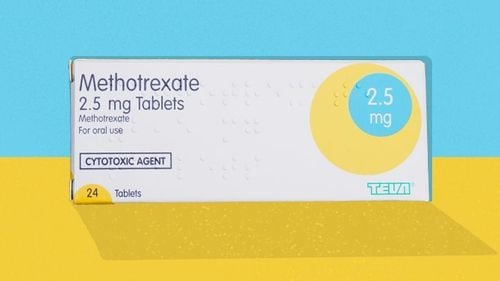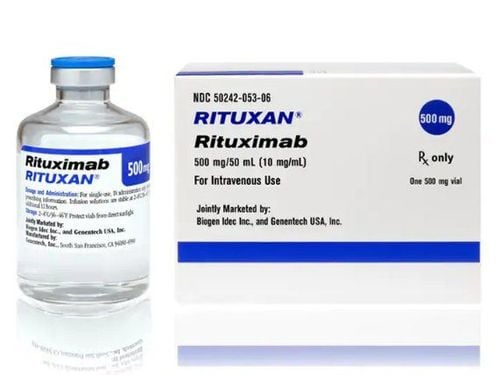This is an automatically translated article.
Stadasone 16 is made in the form of tablets, with the main ingredient being Methylprednisolone. The drug is used as an anti-inflammatory or immunosuppressive drug, mainly used to treat a number of diseases of inflammatory, allergic, hematological, oncological and autoimmune etiology.
1. Uses of Stadasone
1 Stadasone tablet contains 16mg of Methylprednisolone and other excipients. Methylprednisolone is a synthetic glucocorticoid, a 6-alpha-methyl derivative of prednisolone. The drug is commonly used in esterified or non-esterified form for the treatment of conditions indicated by corticosteroids.
Methylprednisolone has anti-inflammatory, anti-proliferative and immunosuppressive effects. The anti-inflammatory effect is due to the fact that Methylprednisolone reduces the production, release and activity of anti-inflammatory mediators such as leucotrienes, prostaglandins, histamine, etc., which helps to reduce some of the first symptoms of the inflammatory process. Besides, Methylprednisolone inhibits leukocytes to adhere to the damaged vessel wall, localize in the damaged area, and reduce the permeability in that area. This effect reduces extravasation, pain, swelling.
Methylprednisolone also inhibits the effects of lymphokines, target cells and macrophages, reducing allergic contact dermatitis reactions. In addition, Methylprednisolone inhibits T lymphocytes and sensitive macrophages from reaching target cells. It has anti-proliferative effects, reducing tissue hyperplasia characteristic of psoriasis.
Indications for the use of Stadasone as an anti-inflammatory or immunosuppressive drug for the treatment of a number of diseases caused by hematological, allergic, cancer, inflammatory and autoimmune causes.
Contraindications to the use of Stadasone:
Patients with severe infections, except tuberculous meningitis and septic shock; People with hypersensitivity to the active ingredients or excipients of the drug; Patients with skin lesions caused by fungi, viruses or tuberculosis; The patient is receiving a live virus vaccine.
2. Usage and dosage of Stadasone
Usage: Orally.
Dosage:
Children: Stadasone dosage for children should be based on the severity of the disease and the patient's response. Once an appropriate dose is achieved, the dose should be reduced to the lowest level that maintains clinical response. When using Stadasone oral long-term, should consider the oral regimen every other day. After long-term therapy, Methylprednisolone should be discontinued gradually; Adults: The initial dose is 2-60mg/day depending on the disease, usually divided into 4 times/day; Allergic disease (contact dermatitis): The recommended initial dose is 24mg (6 tablets x 4mg) on the first day, then gradually reduce 4mg daily to 21 tablets for all 6 days; Asthma: In children over 4 years old with more than 3 severe asthma attacks/year and children 5-11 years old with at least 2 severe asthma attacks/year, the dose is 1-2mg/kg/day (maximum 60mg/day). Methylprednisolone can be used in addition to existing therapy for asthma; In adults and deficient should have at least 2 severe asthma attacks/year, the dose is 40-60mg/day, can be taken 1-2 times. The maintenance dose of corticosteroids or long-acting beta 2 agonist bronchodilators may be added to the maintenance dose. A short course of oral corticosteroids (3 to 10 days) can be continued until the patient reaches a maximal expiratory flow rate of 80% of the patient's maximum expiratory flow and until symptoms are resolved. When asthma is well controlled, the dose of oral corticosteroids should be reduced. When using Stadasone drug overdose, patients may have Cushing's syndrome, osteoporosis and muscle weakness. These side effects only occur with long-term glucocorticoid use. If Stadasone is used in too high a dose for a long time, the patient may experience hyperadrenocorticism and adrenal suppression. In these cases, the patient should consider temporary or complete discontinuation of glucocorticoid therapy.
If a dose of Stadasone is forgotten, the patient should take it as soon as possible. However, if it is almost time for the next dose, the patient should skip the missed dose and take the next dose at the scheduled time from the beginning. Patients should not arbitrarily take double the prescribed dose.
3. Stadasone side effects
Stadasone side effects often occur with high doses and long-term use of Methylprednisolone. Methylprednisolone inhibits prostaglandin synthesis, reduces the effects of prostaglandins on the gastrointestinal tract, including inhibiting gastric acid secretion and protecting the gastric mucosa. There are quite a few side effects associated with this effect of glucocorticoids.
When using Stadasone, patients may experience some side effects such as:
Common: Central nervous system: Nervousness is easily excitable, insomnia; Digestion: Indigestion, increased appetite; Skin: Hairy; Endocrine and metabolic: Diabetes; Nervous - muscle and bone: Joint pain; Eyes: Glaucoma, cataracts; Respiratory: Nosebleeds; Uncommon: Central nervous system: Convulsions, brain pseudotumor, dizziness, headache, psychosis, hallucinations, delirium, euphoria, mood swings; Cardiovascular: Hypertension, edema; Skin: Skin atrophy, bruising, acne, tissue hyperpigmentation; Endocrine and metabolic: Hypokalemia, glucose intolerance, pituitary-adrenal axis suppression, Cushing's syndrome, growth retardation, amenorrhea, alkalosis, sodium and water retention, hyperglycemia; Gastrointestinal: Nausea, vomiting, abdominal distension, esophagitis, gastric ulcer, pancreatitis; Nervous - muscle and bone: Osteoporosis, fracture, muscle weakness; Other: Hypersensitivity reactions. When experiencing side effects of Stadasone, patients should immediately notify their doctor or go to the nearest hospital for timely examination, diagnosis and treatment.
4. Be careful when using Stadasone
Some notes for patients to remember before and while taking Stadasone:
Use Stadasone with caution in patients with osteoporosis, mental disorders, duodenal ulcer, gastric ulcer, new vascular access, diabetes, heart failure, hypertension, kidney failure, liver failure, thyroid disease, cataracts, glaucoma, growing children,...; Because of the potential for multiple side effects, Stadasone should be used with caution in the elderly at the lowest effective dose and for the shortest possible duration; Acute adrenal insufficiency can occur if Stadasone is stopped suddenly after a long period of treatment or when the patient is under stress; Using Stadasone in high doses can affect the effectiveness of the vaccine; The effects of Stadasone on the ability to drive or use machines have not been evaluated. However, caution is still needed when using this drug for this group of people; Systemic administration of methylprednisolone to the mother may lead to a slight risk of low birth weight in the neonate. Therefore, when using Stadasone in pregnant women, the benefits should be weighed against the possible risks for both mother and child; Methylprednisolone can pass into breast milk and should be used with caution in nursing women.
5. Stadasone drug interactions
Some drug interactions of Stadasone include:
Methylprednisolone is an inducer of the cytochrome P450 enzyme and a substrate of the P450 3A enzyme. Therefore, this drug has the potential to affect the metabolism of cyclosporin, phenytoin, carbamazepine, erythromycin, phenobarbital, ketoconazole, rifampicin; Phenytoin, rifampicin, phenobarbital and hypokalemic diuretics,... may reduce the therapeutic effect of Methylprednisolone; Methylprednisolone may increase blood glucose. Therefore, patients with diabetes who are taking this drug at the same time need to use a higher dose of insulin. To avoid the risk of drug interactions, patients should inform their doctor about the drugs they are taking, the diseases they have ever had. From there, the doctor will make appropriate adjustments, ensuring the effectiveness of the treatment and avoiding dangerous side effects.
During the use of Stadasone, the patient also needs to remember to follow the doctor's instructions on how to use, dose, and time to take the drug. Patients should not arbitrarily stop taking the drug or change the dose to avoid adverse health risks.
Please dial HOTLINE for more information or register for an appointment HERE. Download MyVinmec app to make appointments faster and to manage your bookings easily.













